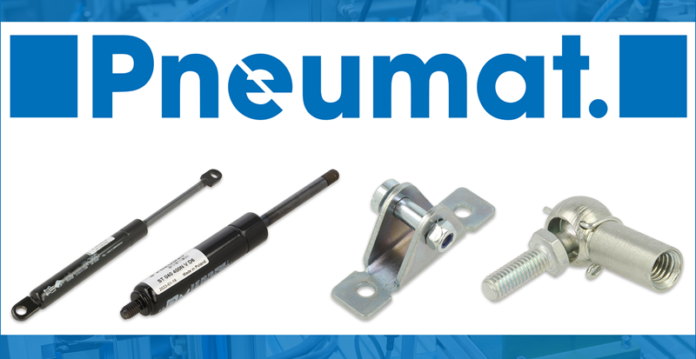
Gas springs have a wide range of diverse applications. For example, it is thanks to them that a heavy boot lid opens practically without any manual help. They also prevent it from closing spontaneously, which might cause serious injuries. State-of-the-art passenger cars come with automatic boot lid control systems, where the user just needs to press a button to activate the electric system supported by gas springs, which open or close the car boot automatically. Gas springs are used in cabinets or storage compartments, but also help operate various platforms and other industrial equipment, and are installed even in construction and agricultural machinery. Moreover, they are used in medical industry, where equipment operated by gas springs sustains and even saves lives.
Regardless of its size, load-carrying capacity or installation location, such factors as intended use and design of each gas spring are almost identical. In short, a gas actuator is designed to lift, pull, push or equalise the weight of the component it controls.
DESIGN, PRINCIPLE OF OPERATION AND BASIC CHARACTERISTICS OF GAS SPRINGS
A gas spring is just a gas-filled cylinder, inside of which a piston rod moves in a reciprocating motion. Obviously, the entire system (both its piston and piston rod) is sealed to avoid nitrogen escape. In order to ensure hydraulic damping, a gas spring is also filled with oil. A piston rod is extremely precisely fitted in the cylinder housing to ensure that the entire system operates smoothly, and actuator resistance corresponds exactly to the manufacturer’s specifications. As a result, each moving element’s stroke must compress the gas filling the cylinder, so that its pressure can rise to the setpoint value. Then the compressed gas releases mechanical force for the gas spring to fulfil its function.

As far as their principle of operation is concerned, two types of gas springs can be differentiated:
- traction springs, designed to pull two engagement points towards each other;
- push springs, designed to push two engagement points away from each other.
Apart from classic solutions, leading manufacturers’ product catalogues also include lockable gas springs. They facilitate locking the piston rod movement along its entire stroke so that the moving component can be set in a specified position.
Mounting
To account for various applications in which gas springs are used, actuator manufacturers have designed three different mounting methods. They offer ring-mounted, articulated, and wall-mounted actuators, the latter mating with the ring-mounted actuators. Moreover, actuators terminated with a thread-mounted attachment are also available.
Gas spring force
The first property that is worth checking when making choice among the various actuators available on the market is the force with which the spring pulls or pushes the component. Note here that an oversized actuator will offer too much resistance to a light load, preventing the entire assembly from operating smoothly enough. Similarly, a gas spring whose force is not able to balance the supported component weight will let it fall, failing to fulfil its purpose. The TME product catalogue contains an extremely wide range of gas springs, with force ratings ranging from 50 N to as much as 5000 N.
Durability
Undoubtedly, the material from which a device is made determines its durability. Most commonly, gas springs are made of chromium-plated steel or stainless steel. Tightness is the key issue determining durability here, as its loss disqualifies a gas spring from further operation. Unfortunately, a gas spring cannot be reconditioned, as gas is applied at high pressure during the production stage, and its enclosure cannot be disassembled and then assembled again.
Dimensions

Geometrical dimensions are another criterion according to which the assortment of gas springs can be divided. Such properties as the outer diameter and piston diameter or its stroke are obviously determined by requirements related to the force that is necessary for an actuator to move or available space. This is related to the fact that a spring operates over the entire cylinder or piston rod length. In some applications, instead of a push spring, a traction spring is used to implement a properly sized actuator in limited space conditions.
GAS SPRINGS – MAIN ADVANTAGES
The myriad of gas actuator applications is the best confirmation of their advantages facilitating their easy adaptation and effective operation. One of such advantages is high durability, even in adverse operating conditions. A well-designed and properly selected gas spring will be trouble-free for years of continuous use.
- A telescopic actuator does not require electricity to operate. This eliminates the risk of compromising its performance due to power outage.
- Thanks to the wide range of available sizes, these accessories can be installed even in hard-to-reach spaces.
- The price-to-performance ratio of such actuators is really favourable, as gas springs do not require any expenditure during their service life, and the price of the product itself is relatively affordable.
- A wide permissible operating temperature range is a key advantage here. Gas springs can be used in very low (even approx. -30°C) and high temperatures (even up to 80°C).
- The gas spring service life is also important. A properly operated actuator should be capable of completing approximately 30,000 full working cycles.
GAS SPRING MAINTENANCE – IMPORTANT ASPECTS
Actuators are often required to run in extreme operating conditions, but the user can still influence their service life and durability to some extent. To this end, both the installation quality and the subsequent use are important. Several guidelines are worth bearing in mind:
- The duty cycle frequency is strictly defined and should not exceed 5 repetitions per minute.
- Due to the fact that piston rod motion is permissible only within one axis, it is strictly prohibited to expose the product to bending stresses. It may result in damaging the seal or spring structure bending.
- The permissible actuator operating temperature limit must not be exceeded.
- The piston rod must not be lubricated. The manufacturer has provided for adequate piston rod lubrication at the design stage, and any attempt to re-lubricate or oil the moving part of the spring can only result in contaminating the enclosure interior.
SELECTING A GAS SPRING – GUIDELINES
As we have mentioned above, the gas spring quality determines its mechanical strength and performance. Due to the fact that gas actuators are often designed to equalise very high loads, they must be totally reliable. Each malfunction might potentially result in severe consequences, such as property damage or hazard to human life and health. Therefore, in order to guarantee the highest possible product quality, one should invest in solutions provided by tried-and-tested manufacturers whose long-standing experience enables them to design fail-safe gas springs.
The ST 100 5000N V D20 model manufactured by Pneumat, one of the leading providers in the field of pneumatic solutions, is a perfect example of a heavy-duty actuator designed to handle very high loads. The manufacturer’s product portfolio also includes a diverse range of gas springs. The relatively inconspicuous gas spring design, i.e. 20 mm diameter piston housed in a 40 mm enclosure, offers the force rating of as much as 5000 N, which is sufficient to handle loads amounting to 500 kg.
Despite the fact that gas springs are often almost unnoticeable, they ensure trouble-free and practically maintenance-free operation, facilitating seamless opening, locking and closing of heavy components. Their presence in our homes allows us to completely ignore the fact that there are mechanical devices in our furniture, cars or beds that make our daily lives much easier. Thanks to them, we can easily operate platforms, booms or other industrial equipment.
The example of a gas spring clearly demonstrates that the simplest design can often operate just as fine as a complex device, but at the same time remain much less prone to failure and much cheaper to buy and use.


















